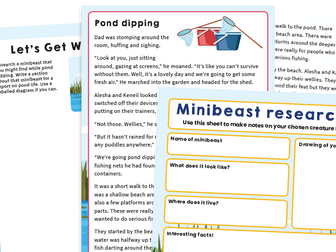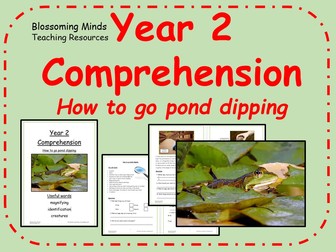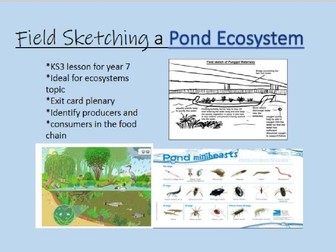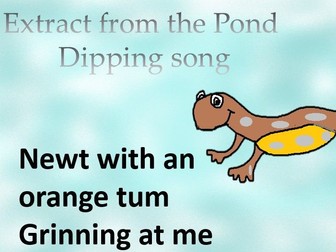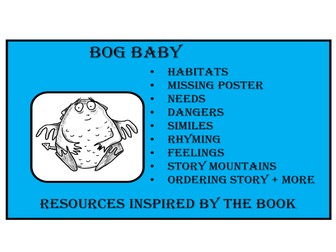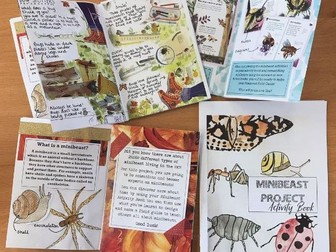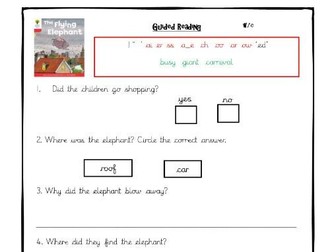
Science at Home - Pond Dipping
This group of resources has been created for use as induction to science work for year 6 students preparing for secondary school. They can generally be used by KS2 and KS3 students (years 3 to 8) though.

A guide to pond dipping
Scientist Janet Sumner talks to some pond dippers about what is involved, during an event at the OUs regional office in Oxford. http://www.ispot.org.uk/

Wildlife Detective: make a pond dipping net
Are there monsters in the pond? Find out by making your own net to catch them.
Simple, fun and easy to follow instructions.
For more instructions on how to make things for investigating nature; including pooters, an animal trap and a sweep net look at our web-site
https://www.rspb.org.uk/forprofessionals/teachers/resources/school-grounds/index.aspx

Minibeasts and pond dipping vocab/Count minibeasts
Symbols (c) Widgit Software 2010. Illustrated vocabulary sheets for minibeasts and pond dipping with tally sheet for minibeasts. Count down in 2s pages for minibeasts includes naming and memory task and opportunities for discussion. Items to count are presented in the same layout as Numicon pieces.

Y2 SATs Practice Pack: Pond Dipping
This resource pack provides opportunities for year 2 pupils to develop comprehension and writing skills in preparation for SATs and end of year assessments. It is part of a collection of resources, covering a variety of fiction and non-fiction texts, and includes a model text with questions and answers, plus a fully resourced writing task. A PowerPoint is also provided.
undefined

Make your own pond dipping net
Use this great activity to learn how to make your own pond dipping net!

How to go pond dipping - non-fiction comprehension - Year 2
This resource is a non-fiction comprehension activity for year 2, perfect for using in the summer term. There are three differentiated sets of instructions on how to go pond dipping, with differentiated questions.
It is based on the KS1 SATs reading paper.
There are a range of 'what, ’ ‘how’ and ‘why’ questions, some multiple choice tick questions and some that require more detailed answers. The activity is also laid out in a similar way to the SATs booklets, with four pages of pictures and short written extracts to read and 2-3 questions per page.
PDF file format and editable Microsoft word format included in the price.

Characteristics of pond creatures
A worksheet for pupils to record the characteristics of pond creatures: number of legs, antennae, wings, how it breathes, type of eater and whether it is a vertebrate or an invertebrate. Ideal to use after pond-dipping. Suitable for year 4 onwards.

Free Pond Ecosystem lesson
A pond is an example of a small-scale ecosystem that we typically student at GCSE Geography. Pond ecosystems depend on balance and equllibrium of all the interdependant parts that make it up; both the living ( biotic) and non-living ( abiotic). This lesson presumes you are lucky enough to have a pond on, or close to your school site to visit and carry out the field sketching tasks. However, if not, there is a detailed picture of a pond ecosystem on the slide they can copy if needed. Students start with a discussions, recap on producers, consumers and decomposers ( this lesson assumes a base-line understanding on food chains). Students sketch the pond with guidance and label appropriately using the mini-beasts spotter card to help them identify animals found on the pond, or through pond-dipping There is an exit card/ small write up task at the end.

Spot It: Ponds
A tick sheet to help you to identify what's living in your pond. Perfect for pond dipping activities.
For other spot it ID sheets for things such as minibeasts or birds and mammals see our website
https://www.rspb.org.uk/forprofessionals/teachers/resources/school-grounds/index.aspx

Pond dipping "What do I see " A song with percussion . Video, Mp3s, PPT, notation, follow up.
Early years and key stage 1.
Song about pond dipping with simple tuned percussion.
Suitable for non specialist
Videos , PPT , backing tracks, notation and follow up ideas
Covers these stages.
Pupils should be taught to:
• use their voices expressively and creatively by singing songs and speaking chants and rhymes
• play tuned and untuned instruments musically
• listen with concentration and understanding to a range of high-quality live and recorded music
• experiment with, create, select and combine sounds using the inter-related dimensions of music.

Pond Life Wordsearch Puzzle Sheet Keywords Settler Starter Cover Lesson Dipping Minibeasts
Wordsearch Puzzle sheet on the theme of 'Pond Lfie'.
Powerpoint so can be used on the board or printed as a worksheet.
Includes space for students to explain the keywords and suggested extension activities. Can take 10 minutes or an hour, depending on which activities the students complete.
Ideal for the start of a lesson, a quick filler, a homework, part of a cover lesson or as a plenary on the board with a whiteboard pen.
The idea behind these is to get students to become more literate and think independently about the words that could be used to describe the topic being taught. The repetition of the word over and over as they look for the word is useful in remembering the terms. Often the students will pick up on things that you would not normally expect!

Food chains, food webs
pond dipping, energy flow, food pyramids, ecological relationships.
Investigating a school pond.
Several different food chains to investigate different habitats.
Tables to collect data from a pond dip.
Interactive links to web sites.
If you don't have Promethean software download viewer from:
http://support.prometheanplanet.com/server.php?show=nav.15853
please leave feedback.

Bog Baby
Resources inspired by a lovely book, which opens up a world of questions to do with, dangers, habitats, feelings etc
This 20+ pack of resources is printer friendly (all black and white).
Included is-
Habitats
Missing Poster
Needs
Dangers
Similes x2
Rhyming
Inferring
Feelings
Labelling
Adjectives
Food
Drawing
Pond Dipping
Retelling the story
Story Mountains
Word Mat

Science - Living things and their habitats - unit of work Year 3 and 4
Unit of work for Living things and their habitats - 2014 curriculum. Including notebook file for all lessons, writing frames to support written work, identification guides for field study in different habitats (garden, woodland, pond dipping). Includes lesson on how to manage environments to encourage wildlife, food chains and choice chamber investigation.

Minibeast Project (English and Science) 3 week project!!
A 3 week writing and science project on minibeasts.
This pack includes a PowerPoint which covers every lesson, an activity booklet and a writing inspiration booklet. This project covers:
Teaching information and resources about minibeats/invertebrates
A minibeast hunting activity with techniques, identification sheets, recording sheets
Teaching resources and an observation activity on food chains: herbivores, carnivores and omnivores
Teaching resources and an activity on minibeast habitats
An investigation into minibeasts’ legs
Inspiration and guidance on how to make a minibeast hotel
Inspiration and guidance on how to make a mini-pond
Inspiration and guidance on how to go pond-dipping
Inspiration and guidance on how to make a pitfall trap
Inspiration and guidance on how to make a potato trap
Teaching videos about minibeasts
A series of lessons on classification keys
Inspiration and guidance on how to make a minibeast field guild
Children will end the project by creating their own minibeast field guide

Wildlife Detective: Make an animal tracker
Find out what has been out at night while you’ve been fast asleep!
Simple, fun and easy to follow instructions.
For more instructions on how to make things for investigating nature; including pond dipping nets, a pooter and a sweep net look at our web-site
https://www.rspb.org.uk/forprofessionals/teachers/resources/school-grounds/index.aspx

Oxford Reading Tree - Level 4 Comprehension Worksheets
A selection of comprehension worksheets to go alongside the teaching of the following Oxford Reading Tree Books:
Animal Feet
Come In
How To Pond Dip
Long Legs
The Flying Elephant
I started to create these comprehension sheets to support my current class.
I hope to create a worksheet that is accessible for that reading level/ability. I often find the comprehension sheets to be quite complex for the reading ability.
These sheets are designed for the child to complete independently after a guided reading session.

Wildlife Detective: Make a pitfall trap
Do you know what’s running around here at night? This is how you can find out. It could be your catch of the day!
Simple, fun and easy to follow instructions.
For more instructions on how to make things for investigating nature; including pond dipping nets, a pooter and a sweep net look at our web-site
https://www.rspb.org.uk/forprofessionals/teachers/resources/school-grounds/index.aspx

Wildlife Detective: Make a bottle bug catcher
How do you get a bug’s-eye view without them running away? An old drinks bottle makes a brilliant two-in-one bug catcher.
Simple, fun and easy to follow instructions.
For more instructions on how to make things for investigating nature; including pond dipping nets, a pooter and a sweep net look at our web-site
https://www.rspb.org.uk/forprofessionals/teachers/resources/school-grounds/index.aspx

